 |
 |
 |
Our route:
06.06.03 - 07.06.03:
Jarash (Gerasa)
Qalaat ar Rabat
08.06.03:
Amman
Salt
09.06.03 - 12.06.03:
Madaba
13.06.03:
Wadi al Mujib
14.06.03:
Kerak
15.06.03:
Wadi al Hasa
16.06.03 - 18.06.03:
Tafila
Dana nat. park
19.06.03 - 22.06.03:
Petra
23.06.03 - 25.06.03:
Wadi Rum
26.06.03 - 29.06.03:
Aqaba/Red sea
30.06.03:
Dead sea
01.07.03:
Amman
02.07.03:
Hammamed Main
03.07.03:
Madaba
04.07.03:
Pella
05.07.03 -06.07.03:
Umm Qays
|
|
|
 |
| Jordan |
 |
 |
 |
 |
 |
 |
On this page, we (will) describe our experiences in Jordan.
Apart from the travelogue for this country
you will also find a number of links to useful sites,
ranging from general information to embassy homepages.
Written by: Dorrit
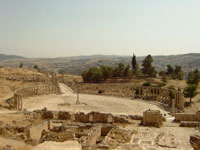 The border crossing is not only taking ages, it is also terribly hot: 40°C. All around us are men in long white dresses with red-and-white scarves on their heads and women fully covered in black, including a black scarf covering their face (how can they still see anything?) and black gloves. The road to Jarash appears to be part of the pilgrim's road, because we keep seeing road signs to Mecca, Medina and Baghdad. Jarash used to be a beautiful Roman city, in its centre an oval shaped, colonnaded square. The theatre, city gates and early-Byzantine churches with their mosaics are all well preserved and are still being used during the theatre festival in summer. In the town of Jarash people don't seem to be used to seeing women without headscarf; the men are shouting things to me and there is a lot of "accidental bumping", although I am well covered despite the heat.
The border crossing is not only taking ages, it is also terribly hot: 40°C. All around us are men in long white dresses with red-and-white scarves on their heads and women fully covered in black, including a black scarf covering their face (how can they still see anything?) and black gloves. The road to Jarash appears to be part of the pilgrim's road, because we keep seeing road signs to Mecca, Medina and Baghdad. Jarash used to be a beautiful Roman city, in its centre an oval shaped, colonnaded square. The theatre, city gates and early-Byzantine churches with their mosaics are all well preserved and are still being used during the theatre festival in summer. In the town of Jarash people don't seem to be used to seeing women without headscarf; the men are shouting things to me and there is a lot of "accidental bumping", although I am well covered despite the heat.
Fortunately, we later find out that this is not typical for Jordan.
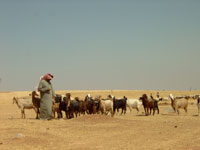 Due to the heat we have to adapt our daily program: we get up early, go see something, spend the whole afternoon (10:30 - 17:30) in the shade doing nothing and after that go see something else. It works pretty well. Near Qalaat ar Rabat, another castle from the times of the Crusades, we lazed about between the olive trees all day and went to see the fortress and the magnificent view over the West bank the next morning. Then we drove to Jordan's capital Amman to see if our IICD-contact Mohammad could arrange some trainings for us. Without city map or address, only having the name of the building Mohammad was working in, we managed to find the place by asking many times. The credits for that go to the people of Amman, who all seemed to know the building, rather than to us. Mohammad arranges a training in Madaba, just south of Amman. In the evening he invites us home in Salt, a great Ottoman town west of Amman, where narrow market streets and renovated 19th century mansions dominate the city's appearance. Mohammad's family is of Palestine origin, just like over 60% of Jordan's population. We are having a delicious Palestinian dish - rice and meat rolled in wine leaves - and spend the rest of the evening chatting with Mohammad and his brother and sisters. His youngest sister just returned from Baghdad, where she studied Hebrew at the university (...).
Due to the heat we have to adapt our daily program: we get up early, go see something, spend the whole afternoon (10:30 - 17:30) in the shade doing nothing and after that go see something else. It works pretty well. Near Qalaat ar Rabat, another castle from the times of the Crusades, we lazed about between the olive trees all day and went to see the fortress and the magnificent view over the West bank the next morning. Then we drove to Jordan's capital Amman to see if our IICD-contact Mohammad could arrange some trainings for us. Without city map or address, only having the name of the building Mohammad was working in, we managed to find the place by asking many times. The credits for that go to the people of Amman, who all seemed to know the building, rather than to us. Mohammad arranges a training in Madaba, just south of Amman. In the evening he invites us home in Salt, a great Ottoman town west of Amman, where narrow market streets and renovated 19th century mansions dominate the city's appearance. Mohammad's family is of Palestine origin, just like over 60% of Jordan's population. We are having a delicious Palestinian dish - rice and meat rolled in wine leaves - and spend the rest of the evening chatting with Mohammad and his brother and sisters. His youngest sister just returned from Baghdad, where she studied Hebrew at the university (...).
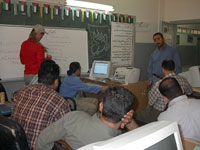 Before going to Madaba, we visited Mount Nebo. Here Moses first saw the promised land Israel and after showing it to his Israelites, he died on this mountain. When the weather is clear enough, you can see Jerusalem and Jericho, but we don't see much more than the Dead sea. In the partly Christian town of Madaba many Byzantine mosaics have been found, the most important being a map of Palestine with all the major towns and cities between Syria and the Nile.
Before going to Madaba, we visited Mount Nebo. Here Moses first saw the promised land Israel and after showing it to his Israelites, he died on this mountain. When the weather is clear enough, you can see Jerusalem and Jericho, but we don't see much more than the Dead sea. In the partly Christian town of Madaba many Byzantine mosaics have been found, the most important being a map of Palestine with all the major towns and cities between Syria and the Nile.
The two following days we teach FrontPage, Web design and Internet for teachers at the Secondary School for boys in Madaba. Unfortunately, there is no network anymore and there is only one computer with internet, so we cannot teach more than 5 to 10 teachers at a time.
During these days we park the car in the schoolyard. Consequently, from 7 am onwards the car is surrounded by crowds of schoolboys who knock on the car, throw little stones, try to peep inside or shout "hello". They are stunned when they see a woman appear from the bus (and without head scarf too) and are more stunned when they see that this woman is actually entering their school.
After the trainings one of the teachers, Amjad, is showing us around in Madaba and invites us to his home. His mother gives me two beautifully embroidered dresses to wear in Iran and serves the national Jordan dish "mansaf", a large plate with rice and meat in yoghurt sauce, which you have to roll to little balls with your (right) hand. Delicious!
The next day we had mansaf again, because one of the teachers was leaving and at his leaving due all the schools teachers had mansaf together.
On the day after that, Amjads sister Majida invites me to the girls' school (which is a lot cleaner and more organized than the boys' school) and to the bachelor party of a catholic colleague of hers. There, and at the girls' school I get the impression that the Christians and the Muslims may be living peacefully next to each other, but have little contact with each other. In the meantime, Coen is invited at the home of a Palestinian school boy for dinner and is shown around in the Palestinian refugee camp of Madaba.
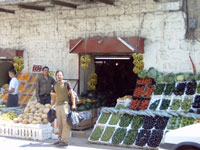 Via the King's Road, the 4000 year old trading route from Egypt to the north that was used by Moses and the Israelites, we drive south. It is a fantastic ride through barren hills and deep valleys, the so-called "wadis". Especially Wadi-al-Mujib - the "Grand Canyon of Jordan" - and Wadi-al-Hasa are worth mentioning here. Both canyons are very steep and their walls are beautifully shaped. At the bottom of the brown-beige rocks the river, with many trees and plants on both its banks, waves its way through the canyon like a large, green ribbon.
Via the King's Road, the 4000 year old trading route from Egypt to the north that was used by Moses and the Israelites, we drive south. It is a fantastic ride through barren hills and deep valleys, the so-called "wadis". Especially Wadi-al-Mujib - the "Grand Canyon of Jordan" - and Wadi-al-Hasa are worth mentioning here. Both canyons are very steep and their walls are beautifully shaped. At the bottom of the brown-beige rocks the river, with many trees and plants on both its banks, waves its way through the canyon like a large, green ribbon.
In Kerak we visit another crusader castle and buy a water pipe to smoke during the hot hours of the day. Shopping in Jordan is a real event; before you know it you are drinking coffee at the fire brigade or police station, or sipping tea at someone's home. People are extremely friendly and hospitable, although the first question they always ask is whether you are an American. If you can answer that with "no", people defrost significantly. Even more than in Syria, you hear "Welcome to Jordan" from all sides. Everyone seems happy to see you.
In Tafila we are being stopped by the police, who wants to be sure we are staying at a safe place during the elections for parliament on the next day. "Not that it will be violent, just some people firing their guns in the air". We spend the next two days in a nature reserve, for us no shooting Arabs. In the (Dana-) reserve we did some nice hiking and saw some beautiful nature, e.g. a bright blue lizard. We were visited by a family of 20 people, whose unmarried women were very interested in the fact that I still had an unmarried brother. There were no offers for camels or speedboats though.
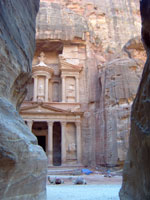 Petra is the absolute queen of all the antique sites we have seen so far. True, it is rather touristy - you have to keep refusing all the steadily repeated offers for donkey, camel, horse or coach rides and tell the sellers of Bedouin jewels time after time that you are really not interested - but you immediately forget all these minor annoyances as soon as you see the fabulous, 2000 year old facades in their marvellous surroundings.
Petra is the absolute queen of all the antique sites we have seen so far. True, it is rather touristy - you have to keep refusing all the steadily repeated offers for donkey, camel, horse or coach rides and tell the sellers of Bedouin jewels time after time that you are really not interested - but you immediately forget all these minor annoyances as soon as you see the fabulous, 2000 year old facades in their marvellous surroundings.
To get to the ancient city, you first have to walk 1.2 km through the so-called "siq", a 2 metres broad, about 100 metres deep canyon of red sand stone. Between those towering walls on both sides you suddenly feel very small. The colours of the sandstone vary from yellow via blue and grey to pale pink and its main colour wine red. At some spots the stone looks like a piece of wood, with wood grains and year rings, at other places it looks as if someone has painted roses on the wall. When you come nearer you see that it is "only" eroded sand stone after all.
At the end of the siq the first building of the ancient city appears: the treasury. In pale pink the classical facade of the temple contrasts with the wine red rock wall surrounding it. So beautiful that we have been staring at it for minutes, sitting on a bench opposite of it.
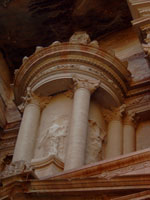
If you walk on, more ancient facades hewn into the rock wall follow, most of them rather eroded in the past centuries. Usually they are rose red, but some have more colours and the erosion has made their surfaces so smooth that they seem to be made of marble instead of sand stone. Very impressive are the kings' graves, a whole row of enormous facades cut out of the steep rock wall and ornamented with all kinds of little columns, bays and alcoves. Everything around you is made of rose sand stone, everywhere you look you see different shades of rose, even the plants have rose flowers.
We walk to the canyon at the opposite end of the valley - passing several temples and theatres that have been cut out of the rocks - and take a donkey ride to the so-called "monastery" at the top of the mountain. The ride goes through a magnificent gorge full of rock graves and ends in front of the 45x50 metres large temple facade in yellow (not rose!) sand stone. It is the biggest temple in Petra, sitting very impressively at the mountain top in the otherwise deserted area.
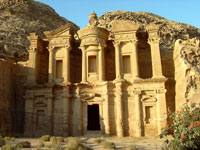
In the evenings we sit in front of our van directly in front of the entrance (so near is no hotel) and smoke water pipe. The army base of Petra is giving us private security; when they found out we were camping here, they sent two soldiers to watch over us. We offer them tea, the least we can do! They tell us that until September 2001 there were at least 3000 visitors a day. Now we are nearly the only ones, bad for the tourist industry in Petra, but good for us; it makes it a lot more fun to visit Petra alone.
The third morning however, we have to leave this superb camping place to make way for the helicopters of Colin Powell, who wants to visit Petra too. Tssk. Suddenly there is a lot more security, everywhere there are jeeps with machine guns on the roof and there are whole crowds of uniformed men. We notice that those parts of the site that are normally closed for public are now open for Colin and his delegation and we decide to seize the opportunity and join their group. An embassy employee from Amman wants to know who we are and what we do here, but when he finds out we are no terrorists he doesn't mind us joining the group.
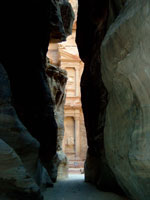 After our extensive, three day visit to Petra we leave for Wadi Rum, one of the most beautiful desert valleys in Jordan. Here we do a two-day jeep safari with accommodation in a Bedouin tent.
After our extensive, three day visit to Petra we leave for Wadi Rum, one of the most beautiful desert valleys in Jordan. Here we do a two-day jeep safari with accommodation in a Bedouin tent.
The jeep safari starts with a drive through the village, searching for someone who sells petrol. Only the third person we ask actually has petrol: from one of the many jerry cans in his barn he pours the petrol via a funnel into the tank of the "jeep" (an old, battered Nissan pickup without 4 wheel drive). There are no petrol stations in this area.
Then we cross through the loose sand into the desert with that old piece of rust, without side windows, spare tire or spare oil. Around us wine red, nearly square mountains are looming up; like sky scrapers along a broad traffic way they are standing in rows opposite of each other. In the middle a large "roundabout" of bright red sand, surrounded by red sand dunes with green dots of grass. At the horizon we see the brown Bedouin tents and herds of grazing camels.
After some kilometres the colours change: the sand turns from rose red into orange, then bluish grey, cream white and finally beige. Here the mountains are no longer wine red but surface as enormous yellow ochre islands from the beige sea of sand.
Whatever colour the rocks have, their forms are bizarre everywhere: huge rock bridges that came into being as erosion cut a hole into the rock wall, "wedding cakes with caramel sauce" of rose sand stone, narrow gorges and animal shaped peaks. According to our guide this area has long ago been under water, which explains the heavy erosion and the smooth shapes. We have a look at some 2000 year old rock drawings and see a red fox running past us at only 2 or 3 metres distance, then the inevitable takes place: the car breaks down. The clutch fluid has leaked away after we crossed through the desert a bit too roughly. No worry: our guide just sucks out the brake fluid from its reservoir with the hose of screen washer and pours it over in the reservoir of the clutch fluid ... brakes are for sissies.
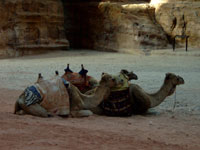 Still in one piece we are being dropped at the Bedouin family, in a solitary tent in the middle of this gigantic desert. We talk a little with the Bedouins, who try to teach us Arabic, and then take a nap in the shade. The Bedouins live like nomads in the desert with their herds of goats and camels. They live in a tent of goat hair, which is actually not much more than a goat hair roof on wooden pillars and some mattresses on the sand floor. We get company from the only other tourist in Wadi Rum: a US American (brave!) called Michael. The lunch - boiled goat meat and sandy bread - is not very promising, but we are "lucky": the Bedouins just shot an ibex - a protected, nearly extinct animal that you are absolutely not allowed to shoot - so we have mansaf with ibex meat for dinner. I am very hungry and despite my bad conscience the mansaf tastes great. Until I find a jaw bone and realize that not only the ibex' sirloin has been processed in this dish. The mansaf is being served on a large plate, which is put on the sand. Everyone (i.e. all the men and me) is squatting on the ground around it and rolls little balls with his right hand. The Bedouins like to chat with us, but ignore Michael. The usual reaction if people hear he is from the States, he says. Before going to bed we take a short walk in the desert and enjoy the best starlit sky I have ever seen so far. We see innumerable falling stars and comets and I have never seen the milky way so clearly as this night. We fall asleep with the sound of barking prairie dogs.
Still in one piece we are being dropped at the Bedouin family, in a solitary tent in the middle of this gigantic desert. We talk a little with the Bedouins, who try to teach us Arabic, and then take a nap in the shade. The Bedouins live like nomads in the desert with their herds of goats and camels. They live in a tent of goat hair, which is actually not much more than a goat hair roof on wooden pillars and some mattresses on the sand floor. We get company from the only other tourist in Wadi Rum: a US American (brave!) called Michael. The lunch - boiled goat meat and sandy bread - is not very promising, but we are "lucky": the Bedouins just shot an ibex - a protected, nearly extinct animal that you are absolutely not allowed to shoot - so we have mansaf with ibex meat for dinner. I am very hungry and despite my bad conscience the mansaf tastes great. Until I find a jaw bone and realize that not only the ibex' sirloin has been processed in this dish. The mansaf is being served on a large plate, which is put on the sand. Everyone (i.e. all the men and me) is squatting on the ground around it and rolls little balls with his right hand. The Bedouins like to chat with us, but ignore Michael. The usual reaction if people hear he is from the States, he says. Before going to bed we take a short walk in the desert and enjoy the best starlit sky I have ever seen so far. We see innumerable falling stars and comets and I have never seen the milky way so clearly as this night. We fall asleep with the sound of barking prairie dogs.
The southernmost goal so far is Aqaba, a town at the south coast of Jordan. Here, many borders come together, so that you can see both Egypt, Israel and Jordan from the beaches of Aqaba, and only have to drive 15 km to be in Saudi-Arabia. The Red sea is - just like the Black sea - blue like all the other seas, so don't let anyone fool you. It is more than hot here: during the day about 46°C, during the night it cools down nicely to about 40°C. When we come back after an hour of shopping, a lighter that was lying in the car had exploded from the heat. The only place where it is nice and cool is the sea.
In the internet cafe in Aqaba we read that Coen's grandfather also died and will be buried tomorrow. And just like in Syria it is hard to phone the family, because the Jordan telecom went broke last month and thus all public phones are out of order. On moments like this you wish you were at home.
We don't get much chance to mourn yet though, we are no two minutes at the beach before the first Bedouin family next to us invites us for tea and then for dinner. We have to stay with them the rest of the day, they cannot accept to let us - a guest in their country - sit by ourselves. The man camping next to us also wants to take us everywhere and show us around and the family camping in a little tent on the beach a few metres further down wants us to drink coffee and have dinner with them. Help! We are drowning in the Arabic hospitality.
We buy two sets of snorkels and go for the real attraction of Aqaba: the underwater world of the Red sea. What seems an ordinary sea from above, turns out to be a real paradise underneath the surface: magnificent coral reefs in many colours, between them fish you normally only see in an aquarium. Schools of gold fish, black and white striped zebra fish, indigo fish with red dots, bright lilac or fluorescent yellow fish and the beige-grey striped lion fish. The latter is sitting on stones like a spider and is pretty dangerous according to the warning posters at the beach. Its sting equals that of a scorpion. Yugh. At the bottom of the sea brown-black striped water snakes and huge black "socks" named sea cucumbers are lying on the floor.
Although the public beach has better facilities than any beach in Western Europe (daily cleaning, new toilets and showers, straw parasols, parking places and at night light and guards), we escape to the Royal Diving Club (for western tourists and Arabic Christians) after two days. Here we are not harassed by swarms of staring children who shout "I love you" and follow every move you make. Nor are we invited by families for tea or dinner here, but can have a good rest and swim in bathing suit instead of long skirt and t-shirt. Besides, the coral reef is much nicer here and there are no jet ski's racing over it.
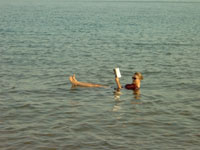 Via the extremely hot and dry Jordan valley we drive back north to the Dead sea. Because of the heat we decide not to go to Egypt now, we heard it is even hotter there than in Aqaba. Besides you have to pay at least EUR 300 before the border guards even so much as look at your carnet de passage, so we will just have to save Egypt for some other time.
Via the extremely hot and dry Jordan valley we drive back north to the Dead sea. Because of the heat we decide not to go to Egypt now, we heard it is even hotter there than in Aqaba. Besides you have to pay at least EUR 300 before the border guards even so much as look at your carnet de passage, so we will just have to save Egypt for some other time.
The Dead sea is the lowest place on earth: its surface lies about 400 metres below sea level, its bottom about 850 metres. Here, it is at least as warm as in Aqaba. The sea itself consists for 30% of salt (10 times as much as the oceans!), so hardly anything can live in it. Which would explain why it is called Dead sea. A nice side effect of the high salt concentration is that you are being pushed upwards by it. If you lie in it you float, if you stand upright and try to sink under water you can barely manage to get your shoulders under water and if you stop trying to sink the water pushes you up until you lie floating on your back again. Because of the high salt concentration the water cannot cool down, so unlike the Red sea the water is lukewarm instead of nice and cool.
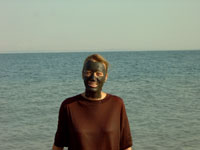
Here too we can choose between a free public beach and a hotel beach for westerners. This time however, the hotel beach does not cost EUR 4 but EUR 30 per person per day. Which means we end up at the public beach with the staring Arabs (or "Starabs" as Coen likes to call them). Although I am wearing my long skirt and t-shirt again, some of them seize this opportunity, stop whatever they were doing, sit down and stare.
Just like in Aqaba this beach has all the facilities you can imagine, this one even has a big park around it. Only the showers do not work yet, they have only just been built. A big problem if you come out of the Dead sea, which covers you with a thick layer of salt within 10 minutes. And that really burns in the hot sun. We have no problem with that, however, we have a shower in the van! At precisely 8 pm an army unit orders everybody to get out of the water: from sunset to sunrise bathing in the Dead sea is not allowed. After all, this is still border area with Israel.
In Amman we visit the enormous Roman theatre that lies right between the modern buildings of the city, drink tea with our IICD contact Mohammad and smoke water pipe with an Iraqi who is living in Holland since 15 years. Since the embargo on Iraq has been lifted a few weeks ago, he is exporting second hand cars to Iraq. It seems to be good business, we saw thousands of cars at the container port of Aqaba, ready to be driven to Baghdad.
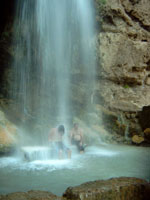 One of the other things on my wish-list were the hot waterfalls of Hammamed Ma'in south of Madaba. The hot spring water falls down 45 metres along limestone rocks. This made the rocks look like those in Pamukkale (Turkey), but because of the many minerals in the water they are not white but green and orange. Behind the waterfall in the rock wall there was a little cave where an even hotter source (90°C) came bubbling out. The steam of the source turned the cave into a sort of natural Turkish steam bath. Here we sat under the waterfall and sweated in the steam cave. As if the past few weeks have not been hot enough.
One of the other things on my wish-list were the hot waterfalls of Hammamed Ma'in south of Madaba. The hot spring water falls down 45 metres along limestone rocks. This made the rocks look like those in Pamukkale (Turkey), but because of the many minerals in the water they are not white but green and orange. Behind the waterfall in the rock wall there was a little cave where an even hotter source (90°C) came bubbling out. The steam of the source turned the cave into a sort of natural Turkish steam bath. Here we sat under the waterfall and sweated in the steam cave. As if the past few weeks have not been hot enough.
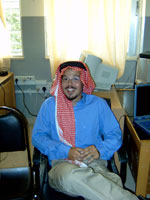 On the way back we wanted to visit Amjad in Madaba again, but he was just having an ICDL-exam (computer teaching is taken very seriously in Jordan, every teacher has to do this international computer exam). We decide to stay in Madaba that day anyway and when we smoke a water pipe that evening in one of the little bars, Amjad suddenly stands next to us after all. He had asked around in town and people had told him we would be here, and that we spent the afternoon in the swimming pool. This definitely beats my home village Numansdorp in the international gossip league! Amjad took us home where his sister Amjaad was celebrating getting her university grade. Like her, many others celebrated getting their diplomas: everywhere in town people were having parties, with a lot of people shooting their guns in the air. The party at Amjad's was divided in two: the front room for the men, the back room for the women. While the women sang and danced, the men discussed politics (according to Coen).
On the way back we wanted to visit Amjad in Madaba again, but he was just having an ICDL-exam (computer teaching is taken very seriously in Jordan, every teacher has to do this international computer exam). We decide to stay in Madaba that day anyway and when we smoke a water pipe that evening in one of the little bars, Amjad suddenly stands next to us after all. He had asked around in town and people had told him we would be here, and that we spent the afternoon in the swimming pool. This definitely beats my home village Numansdorp in the international gossip league! Amjad took us home where his sister Amjaad was celebrating getting her university grade. Like her, many others celebrated getting their diplomas: everywhere in town people were having parties, with a lot of people shooting their guns in the air. The party at Amjad's was divided in two: the front room for the men, the back room for the women. While the women sang and danced, the men discussed politics (according to Coen).
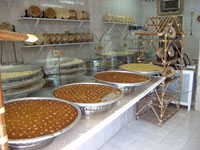 Our last two stops before the Syrian border are Pella (named after the Macedonian birth place of Alexander the Great) and Umm Quays. In Pella we have a splendid view over the West Bank and Jericho, in Umm Quays over Tiberias, lake Genezareth and the Golan heights. At the Roman excavation site in Umm Quays some boys are shooting with a rifle in the bushes. I realize they are no poachers after all, when they come out again, carrying a 2 metre long grey snake; "the lady of Umm Quays". They tell us its bite is lethal, that is why they hunt it. Brrr. We can only camp here near the police station and have to register, because this is a "sensitive area". This becomes clear when it gets dark: the whole border valley is being lit and the area around it are constantly scanned with search lights. Apart from that, there are army checkpoints everywhere; every 2 km you have to show your passport and the inside of the van. The police officers seem to find it very interesting that we are parked there: one after the other they come for a tea and a chat, in ascending hierarchical order. They have nice bedtime stories about their Angola missions (here in Jordan the police also takes part in UN-missions), where the only participating Dutch soldier was eaten by a crocodile...
Our last two stops before the Syrian border are Pella (named after the Macedonian birth place of Alexander the Great) and Umm Quays. In Pella we have a splendid view over the West Bank and Jericho, in Umm Quays over Tiberias, lake Genezareth and the Golan heights. At the Roman excavation site in Umm Quays some boys are shooting with a rifle in the bushes. I realize they are no poachers after all, when they come out again, carrying a 2 metre long grey snake; "the lady of Umm Quays". They tell us its bite is lethal, that is why they hunt it. Brrr. We can only camp here near the police station and have to register, because this is a "sensitive area". This becomes clear when it gets dark: the whole border valley is being lit and the area around it are constantly scanned with search lights. Apart from that, there are army checkpoints everywhere; every 2 km you have to show your passport and the inside of the van. The police officers seem to find it very interesting that we are parked there: one after the other they come for a tea and a chat, in ascending hierarchical order. They have nice bedtime stories about their Angola missions (here in Jordan the police also takes part in UN-missions), where the only participating Dutch soldier was eaten by a crocodile...
Dorrit
|
 |
|
 |
 |
 |
 |
Our top 5: |
 |
 |
1. Petra
2. Red sea
3. King's Road
4. Wadi Rum
5. Dead sea
|
 |
 |
 |
 |
 |
 |
 |
 |
TIP: |
 |
 |
Visa for Jordan can be bought at the border without problems.
|
 |
 |
 |
 |
 |
 |
 |
 |
Border costs: |
 |
 |
1. Administration
costs: EUR 7
2. Car insurance:
EUR 60 / month
3. Visa:
EUR 35 / person
4. Carnet processing:
EUR 20
|
 |
 |
 |
 |
 |
 |
 |
 |
TIP: |
 |
 |
You will find ATM's in nearly all larger towns and cities in Jordan
|
 |
 |
 |
 |
 |
 |
|


